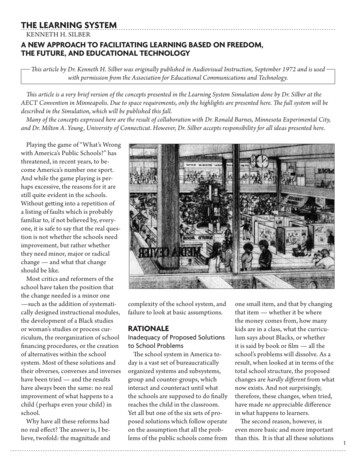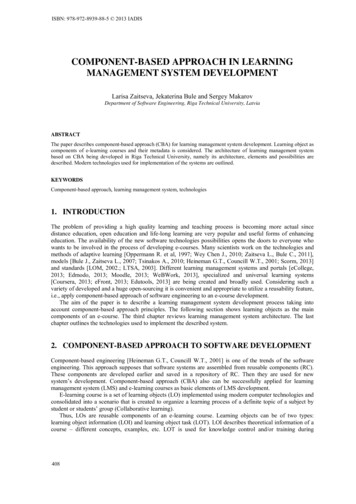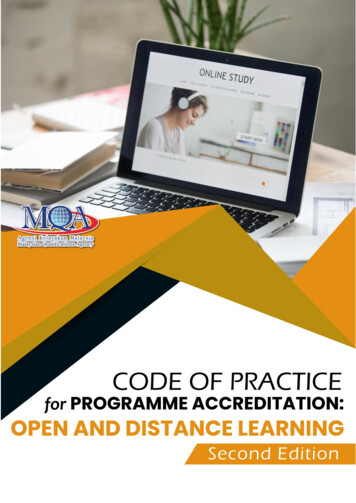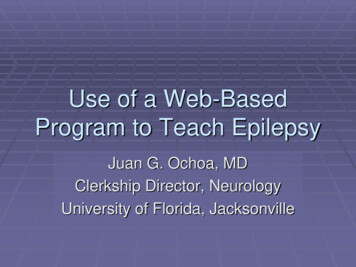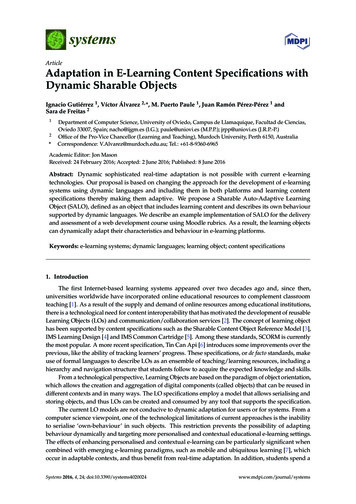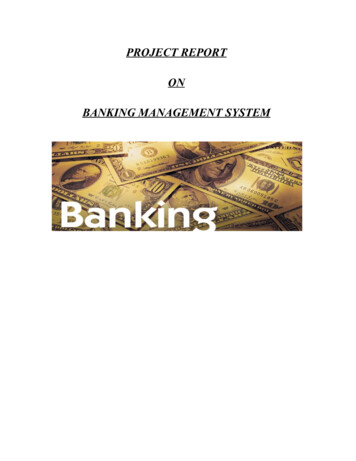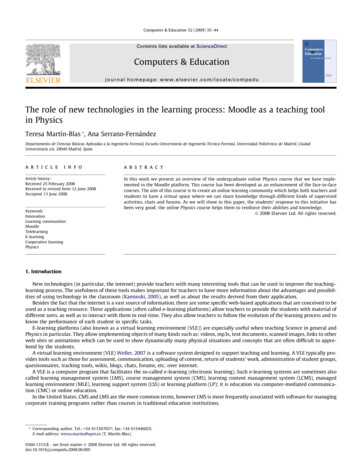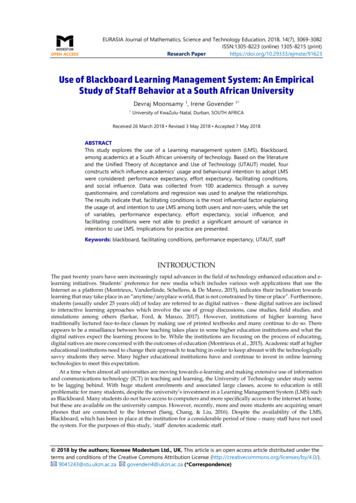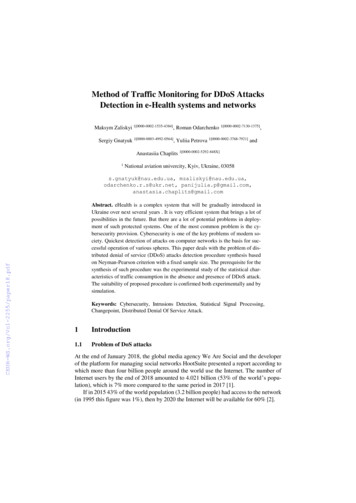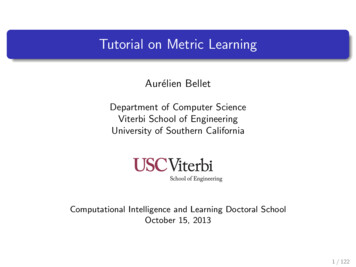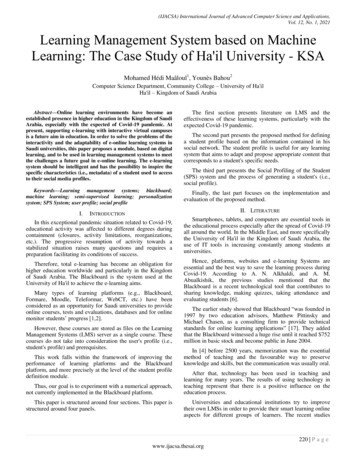
Transcription
(IJACSA) International Journal of Advanced Computer Science and Applications,Vol. 12, No. 1, 2021Learning Management System based on MachineLearning: The Case Study of Ha'il University - KSAMohamed Hédi Maâloul1, Younès Bahou2Computer Science Department, Community College – University of Ha'ilHa'il – Kingdom of Saudi ArabiaAbstract—Online learning environments have become anestablished presence in higher education in the Kingdom of SaudiArabia, especially with the expected of Covid-19 pandemic. Atpresent, supporting e-learning with interactive virtual campusesis a future aim in education. In order to solve the problems of theinteractivity and the adaptability of e-online learning systems inSaudi universities, this paper proposes a module, based on digitallearning, and to be used in learning management systems to meetthe challenges a future goal in e-online learning. The e-learningsystem should be intelligent and has the possibility to inspire thespecific characteristics (i.e., metadata) of a student used to accessto their social media profiles.The first section presents literature on LMS and theeffectiveness of these learning systems, particularly with theexpected Covid-19 pandemic.Keywords—Learning management systems; blackboard;machine learning; semi-supervised learning; personalizationsystem; SPS System; user profile; social profileFinally, the last part focuses on the implementation andevaluation of the proposed method.I.The second part presents the proposed method for defininga student profile based on the information contained in hissocial network. The student profile is useful for any learningsystem that aims to adapt and propose appropriate content thatcorresponds to a student's specific needs.The third part presents the Social Profiling of the Student(SPS) system and the process of generating a student's (i.e.,social profile).II. LITERATUREINTRODUCTIONIn this exceptional pandemic situation related to Covid-19,educational activity was affected to different degrees duringcontainment (closures, activity limitations, reorganizations,etc.). The progressive resumption of activity towards astabilized situation raises many questions and requires apreparation facilitating its conditions of success.Therefore, total e-learning has become an obligation forhigher education worldwide and particularly in the Kingdomof Saudi Arabia. The Blackboard is the system used at theUniversity of Ha'il to achieve the e-learning aims.Many types of learning platforms (e.g., Blackboard,Formare, Moodle, Teleformar, WebCT, etc.) have beenconsidered as an opportunity for Saudi universities to provideonline courses, tests and evaluations, databases and for onlinemonitor students’ progress [1,2].However, these courses are stored as files on the LearningManagement Systems (LMS) server as a single course. Thesecourses do not take into consideration the user's profile (i.e.,student's profile) and prerequisites.This work falls within the framework of improving theperformance of learning platforms and the Blackboardplatform, and more precisely at the level of the student profiledefinition module.Thus, our goal is to experiment with a numerical approach,not currently implemented in the Blackboard platform.This paper is structured around four sections. This paper isstructured around four panels.Smartphones, tablets, and computers are essential tools inthe educational process especially after the spread of Covid-19all around the world. In the Middle East, and more specificallythe University of Ha'il in the Kingdom of Saudi Arabia, theuse of IT tools is increasing constantly among students atuniversities.Hence, platforms, websites and e-learning Systems areessential and the best way to save the learning process duringCovid-19. According to A. N. Alkhaldi, and A. M.Abualkishik, the previous studies mentioned that theBlackboard is a recent technological tool that contributes tosharing knowledge, making quizzes, taking attendance andevaluating students [6].The earlier study showed that Blackboard “was founded in1997 by two education advisors, Matthew Pittinsky andMichael Chasen, as a consulting firm to provide technicalstandards for online learning applications” [17]. They addedthat the Blackboard witnessed a huge rise until it reached 752million in basic stock and become public in June 2004.In [4] before 2500 years, memorization was the essentialmethod of teaching and the favourable way to preserveknowledge and skills, but the communication was usually oral.After that, technology has been used in teaching andlearning for many years. The results of using technology inteaching represent that there is a positive influence on theeducation process.Universities and educational institutions try to improvetheir own LMSs in order to provide their smart learning onlineaspects for different groups of learners. The recent studies220 P a g ewww.ijacsa.thesai.org
(IJACSA) International Journal of Advanced Computer Science and Applications,Vol. 12, No. 1, 2021define LMSs as the web-based system that provides manybenefits for the educational processes [14].systems, its system inefficiencies, and the cost of theBlackboard is really high [17].LMS can be used as an effective tool for studentsbelonging to the same University and studying in differentcampuses [9]. LMS is used to assemble students from adifferent place and different time zone to join the samelecture, to solve the same problem, to do the same quiz or tosit for the same exam.In the past, one of the key limitations of an LMS is thedilemma of how to use new technology in the learning process[5].According to L. A. Bove and S. Conklin (2020), LMS cansimplify and speed the discussions, document sharing, andassignment submission between teachers and their students[13]. Moreover, it helps teachers to better evaluate theirstudents.Consequently, LMS is helpful and useful for students whowitnessed difficulties to move from their home town or homecountries to join the lectures at universities. Additionally,LMS is gainful for special needs students.The cultural aspects of LMS design are of hugeimportance because it can fit the user’s satisfaction which canprovide success stories in education for both students andteachers. In addition, learning materials on LMS can respectgender differences. Next, LMS can afford guidelines forstudents and build a learner-centred educational climate [9].Today, mobile applications make the use of LMS easierand painless. Students can access their LMS accounts despitethe places they are in such as trains, buses, homes, etc.Mobile Apps are considered as a recent infrastructure thatcontributes to the spread of LMS. A. W. Bates (2015) in [8]argued that the social media is a significant technology whichsupports the teaching method since it facilitates the dialoguesand strengths the students’ contribution during the lectures.The Blackboard advances since its foundation until now.The benefits of the Blackboard Learning System are theincreased availability, the quick feedback, the improvedcommunication, the tracking, and the skills building [12].The Digital Report (2020) in Saudi Arabia (https : / a) mentionedthat the number of social media users rise by (8.7%) betweenApril 2019 and January 2020 (about 2 million users). Thereport shows that the most used social media platforms areYouTube (76%), WhatsApp (71%), Instagram (65%),Facebook (62%), and Twitter (58%).However, the statistics show that the preferable socialnetwork for students in the University of Ha'il is WhatsApp[7]. Therefore, we build our study on the consideration of theWhatsApp as the first source of data for the User Profile.Despite the huge number of the users of social mediaplatforms, students cannot access to the Blackboard throughtheir social networking information. Nevertheless, the use ofthe data from the social network let students butter managetheir Blackboard accounts.The previous studies tried to count different drawbacks ofthe Blackboard. They stated that the Blackboard is hard tolearn, its options may be restricted to particular operatingThere are two challenges in online learning the first is toprovide the students with new technological knowledge, thesecond is to attract their attention to follow the main lecture.The serious obstacle that faces the teacher is that students arenot motivated to become expert users of LMS [16].As a result, in the current study, we try to make the LMSeasier for the students at the University of Ha'il through theintegration of students’ data from social networks.In defiance of the advances it witnessed, the LMSBlackboard still faces a serious drawback that the previousstudies did not deal with it: the user profile, this aspect is theone we will work in in the study in hands.A. e-Online Learning ChallengesThe LMS Blackboard is a standard system; it witnessedsome development, but they are not in-depth. Despite thevalidation of advancement on the Blackboard, the LMS is stillincapable to manage the student’s metadata from otherplatforms; it cannot capture student parameters fromWhatsApp, Twitter, Facebook, etc.The present study works on the development of theintegration of the student’s email used in social networks toaccess to the Blackboard, instead of using their University Idnumber (e.g., s20200123). Hence, the student can relate hisBlackboard account with their social media profiles.It is hard for a student to use his preferences; they canforget their Id Number or type it in a wrong way because theyuse it only to access to the Blackboard or during the examdays. Hence, it is difficult for students to use preferences toaccess to the Blackboard LMS system, so we are working inthe current study to facilitate their access into the LMS byusing things with is easy to remember their social mediaparameters since they use it daily and this step aims toimprove the effectiveness of the educational process.The LMS Blackboard cannot configure student’s settingswhich are fixed by the University technical Unit. Even whenthe student’s name is written in the wrong way, he/she cannotcorrect it or make any changes. As a result, the Universitytechnical unit is supreme power when dealing with theBlackboard, whereas the educational process should be basedon the student.B. Concept of user ProfileThe notion of the user profile is widely addressed in usermodelling, which can be considered as the process ofknowledge extraction in order to identify the information andcharacteristics of the user or a group of users [3].The use of the user model in this work improves thequality of human-machine interactions: the deduction of userpreferences and contexts from the activities observed in the221 P a g ewww.ijacsa.thesai.org
(IJACSA) International Journal of Advanced Computer Science and Applications,Vol. 12, No. 1, 2021social media is used to determine the type of dialogue that theLMS system will have with the user.Indeed, the user profile is used to adapt and proposeappropriate content that corresponds to the user's specificneeds [18].Our work deals with the definition of the student profilewhich aims to allow the LMS system to adapt to the user. Thefollowing section explains this aspect, in the context ofinformation customization systems.Our study is used to determine, in a first place, thepersonal data of students that are relatively stable over time,such as their identity (e.g., e-mail, phone number),demographic data (e.g., age, gender, address) and that do notrequire automatic updates.Secondly, we consider that preferences and interests tendto change over time and that designate the characteristics ofthe user such as preferred types of presentation, etc.In this context, our contribution is to propose arecommendation system that is fundamentally based on adigital learning-based technique (i.e., semi-supervisedlearning) and that determines the degree of similarity betweenstudents, in order to recommend the items corresponding to astudent's interest.The choice of the machine learning technique based onsemi-supervised learning is justified by the fact that it allowsinvolving a system with only a small number of labelled itemsstudents and a large number of not labelled ones.The method that we present in this paper aims to processstudent profiles from the e-learning platform. To do so, wehave proposed a digital learning approach [20].III. PROPOSED METHODOLOGYOur proposal aims to predict and determine the preferencesof the student from the information shared in his differentsocial media. This extracted knowledge allows us to build thestudent profile that becomes central in any LMS system.We propose a new method for using the user profile (i.e.,student profile) in a referral system to provide a student withresources (i.e., content and items) relevant to his or herinterests or specific needs in social media.Our method is based on a machine learning technique.More precisely, it is based on the semi-supervised learningtechnique which is composed of two phases: the first one isthe learning phase which allows the system to learn how toprovide a student with personalized resources [15,21]. We usethe J48 algorithm for this phase. The choice of using the J48algorithm is justified by the fact that it has given the best Fmeasure scores in comparison with the classificationalgorithms.The second phase is the use phase, which allows users touse the learning platforms. Fig. 1 shows the details of theproposed method and the two phases (i.e., the learning phaseand the use phase).Fig. 1. Principle of the Proposed Method.A. The Learning PhaseIn this phase, we provide a training corpus and metadatafeatures reflecting the student's interests. This information isdefined following several studies [7].The training corpus is composed of the attributes assignedto student information and their profiles. Attributes areassigned to student information and come from differentcategories: demographic data (e.g., age, gender, address),interests, hobbies, affiliation, preferences [19].All attributes are initially pre-processed to prepare theirsegmentations in gender (i.e., male or female), age,description or structured as vectors (e.g., interests). However,some attributes have only one value (e.g., age, gender) whileothers may have several possible values (e.g., favourite musicgroups, favourite sports, etc.).After the pre-processing step, each student entity (i.e.,attribute) will be notified according to certain metadatacharacteristics. This step leads to the construction of a set of Vvectors corresponding to the values of the specificcharacteristics (i.e., metadata) of a student. These vectors arecalled score vectors. Each vector is associated with classes andindicates the class of the student node.The score vector has the following structure, V1 (A1, A2,A3. An), where Ai is the score of the metadata criteria from ito n (i.e., the number of criteria).In the learning phase, the score vectors are combined toassociate a score to each characteristic and to generateclassification rules.222 P a g ewww.ijacsa.thesai.org
(IJACSA) International Journal of Advanced Computer Science and Applications,Vol. 12, No. 1, 2021B. The use PhaseThis step is based on the construction of a student profilefrom the information contained in his or her social network,which we call "social profiling".The term "social profile" refers to a profile constructedusing the student's social network.A social profile contains metadata reflecting the student'sinterests extracted from the information shared by theindividuals in his or her social network.Our objective in this phase is to build from this sharedinformation on the student's social network, a score vectorbased on affinities (e.g., geographical, affiliation, interests,etc.).Thus, we start this second phase with a step of collectingthe student's shared information in his social network. Animportant point here is data collection problems, which iswidely studied in social network analysis. In order to solvethis problem, several APIs (Application ProgrammingInterface) tools [11] that allow to query and process very largevolumes of data related to public social networks (e.g.,Twitter, Facebook, Instagram) have been applied (this is thestep of collecting a student attribute).After the pre-processing step of the collected data, andwith the score vectors and the result defined by the learningphase using the J48 learning algorithm, which has proven itsefficiency in our proposal, the "social profiling" of the studentwill be defined in this way.To justify the choice of our learning algorithm, we testedfive best classification algorithms according to the F-measureevaluation metric [10]. We deduced that the J48 algorithmgives the best F-measure. Table I summarizes the test resultsof the five algorithms.TABLE I.CLASSIFICATION ALGORITHM TEST Net0.5700.5660.565NaiveBayes0.5420.5450.538Using the study conducted by A. N. Alkhaldi, M. Ali, S.M. Mahmoud, Z. A. Alrefai, and Y. Bahou (2020), we wereable to draw up a list of "features" criteria defining the linksbetween students according to their common points oraffinities (i.e., geographical, affiliation, interests) [7].Note that the implementation requires a pre-processingstep. This is the preparation of the data. Preparation is theprocess of collecting, combining, structuring, and organizingdata so that it can be analysed in data visualization, analysis,and machine learning applications.After the data preparation "pre-processing" step, we usenine "features" criteria to classify and define the metadata ofeach student entity.Finally, we obtain a file that contains all the score vectorsthat make up the contribution of each student entity tolearning. Table II shows features details.In the learning phase, we use the J48 algorithm to learnhow to classify the student entities. At the end of the learningphase, a score is associated with each element. Some featurescan have a grade of zero. The J48 algorithm generates a ruleby summing the scores associated with each student entity.The system uses the generated rules to calculate the score foreach student entity.Finally, the system combines the classification decisions toobtain a social profile of the student. A social profile containsthe metadata reflecting the student's interests extracted fromthe information shared in their social network and classifiedby the result generated by the J48 algorithm.B. Preliminary ResultsWe used 427 student entities from our corpus toexperiment our system (377 student nodes for the learningphase and 50 student nodes for the evaluation phase). Thesummaries obtained are compared to the expert results.The main measures for Precision, Recall and F-Measureare 0.943, 0.961 and 0.952, respectively (see Table III).TABLE II.IV. SPS SYSTEMThe method we proposed for the automatic definition ofsocial profiling of the student was implemented through theSPS system. In this section, we present the implementationdetails and preliminary results.A. Implementation DetailsOur study corpus consists of 427 student nodes collectedfrom a survey questionnaire that was used to collect data fromstudents at Ha'il University in Saudi Arabia and is accessibleto the Blackboard system [7].FEATURES DETAILSFeaturesDetailsStu SexIndicates the type of sex (1 male; 0 female)Stu DiplomaIndicates the type of diploma (Diploma; Bachelor; Master)Stu SpecialityIndicates the speciality of the student (Medical and healthscience; Humanist and social science; Applied science;Natural science)Stu BranchIndicates the geographic location of the studentStu DeviceIndicates using Blackboard system via (Smartphone; PC;Together)Stu Soc MedIndicates the social media most used by students (Twitter;Facebook; Instagram; Other)Stu Pre FilmCalculates the tf*idf of the media preference (tf*idf Film)Stu Pre SongCalculates the tf*idf of the media preference (tf*idf Song)Stu Pre DocCalculates the tf*idf of the media preference (tf*idfDocument)Stu LanguageIndicates the interface language223 P a g ewww.ijacsa.thesai.org
(IJACSA) International Journal of Advanced Computer Science and Applications,Vol. 12, No. 1, 2021TABLE III.Weighted Avg.EVALUATION RESULTSPrecisionRecallF-Measure0.9430.9610.952V. CONCLUSION AND FUTURE WORK[5][6]In this document, we have proposed a method for defininga social profile that reflects the student's interests. Themetadata of the social profile will be useful later on toimprove the efficiency of the Blackboard learning process.Our method is implemented by the SPS system and isbased on the technique of machine learning. Indeed, our workfocuses on a particular type of student nodes (i.e., Ha'ilUniversity students). We believe that the preliminary resultsare very encouraging. Indeed, the F-measurement is equal to0.952.Note, we have used a small corpus for the evaluation andas a perspective, we plan to extend our evaluation to a largercorpus and also to study the effect of other criteria on thedefinition of student social profiling.We also plan to enrich our proposal so that it is able tofollow the evaluation of the student's social profile with avariety of interests and needs over time. We, therefore,propose to keep the profile up to date through profile updatingtechniques, which, starting from an already relevant and up-todate profile, will adjust at each update the interests consideredrelevant based on the former interests of the previous period[16]. It is thus a question of integrating a temporal factor (atemporal measure in the step of extraction and weighting ofstudent interests).We could also consider evaluating the social profilesconstructed within the framework of our proposal in severalLMS, a recommendation system for example the LEDGMENTThis Research has been funded by Scientific ResearchDeanship at University of Ha'il – Saudi Arabia through projectnumber RG-191341.[1][2][3][4]REFERENCESA. Bartuskova, O. Krejcar, and I. Soukal, “Framework of designrequirements for e-learning applied on Blackboard learning system,”Computational Collective Intelligence, Springer International PublishingSwitzerland, pp. 471–480, 2015. https://doi.org/10.1007/978-3-31924306-1 46.A. H. Duin, and J. Tham, The current state of analytics: Implications forLearning Management System (LMS) use in writing pedagogy,”Computers and Composition, vol. 55, article number 102544, March2020.A. Kobsa, Generic user modeling systems, BRUSILOVSKY P.,KOBSA A., NEJDL W. (dirs.), The Adaptive Web, Springer BerlinHeidelberg (Lecture Notes in Computer Science), pp. 136-154, 2007.A. Kukulska-Hulme, E. Beirne, G. Conole, E. Costello, T. Coughlan, R.Ferguson, E. FitzGerald, M. Gaved, C. Herodotou, W. Holmes, C. MacLochlainn, M. Nic Giolla Mhichíl, B. Rienties, J. Sargent, E. Scanlon,M. Sharples, and D. Whitelock, Innovating pedagogy 2020: Open[16][17][18][19][20][21]University innovation report 8, The Open University, Milton Keynes,2020.A. M. Heirdsfield, S. Walker, M. Tambyah, and D. A. Beutel,“Blackboard as an online learning environment: what do teachereducation students and staff think?,” Australian Journal of TeacherEducation, vol. 36, issue 7, 2011.A. N. Alkhaldi, and A. M. Abualkishik, “The mobile Blackboard systemin higher education: Discovering benefits and challenges facingstudents,” International Journal of Advanced and Applied Sciences, vol.6, issue 6, pp. 6-14, 2019.A. N. Alkhaldi, M. Ali, S. M. Mahmoud, Z. A. Alrefai, and Y. Bahou,“Challenges facing students to adopting the Blackboard system: the casestudy of University of Ha’il in Saudi Arabia,” International Journal ofAdvanced and Applied Sciences - IJAAS, vol. 8, issue 3, 2020.A. W. Bates, Teaching in a digital age: Guidelines for designingteaching and learning, Vancouver BC, Tony Bates Associates Ltd.,ISBN: 978-0-9952692-0-0, 2015.H. Tinmaz, and J. H. Lee, “An analysis of users’ preferences on learningmanagement systems: a case on German versus Spanish students,”Smart Learning Environments, vol. 7, 2020. https://doi.org/10.1186/s40561-020-00141-8I. Witten, E. Frank, and M. Hall, “Data mining: Practical machinelearning tools and techniques,” Morgan Kaufmann Series in DataManagement Systems Morgan Kaufmann, pp. 587-605, ISBN: 978-0-12-374856-0 2011. .J. Cutler, and M. Dickenson, “Application programming interfaces,”Computational Frameworks for Political and Social Research withPython, Springer, pp. 87-97, ISBN: 978-3030368258, 2020.J. R. Hipp, C. Bates, M. Lichman, and P. Smyth, “Using social media tomeasure temporal ambient population: Does it help explain local crimerates?,” Justice Quarterly, vol. 36, issue 4, pp. 718-748, 2019.L. A. Bove, and S. Conklin, “Learning strategies for faculty during alearning management system migration,” Online Journal of DistanceLearning Administration, vol. 23, issue 1, pp. 1–10, 2020.L. Li, Zheng, F. Yang, and T. Li, “Modeling and broadening temporaluser interest in personalized news recommendation,” Expert Systemswith Applications, vol. 41, issue 7, pp. 3168-3177, June 2014.https://doi.org/10.1016/j.eswa.2013.11.020.L. Yao, and Z. Ge, “Deep learning of semi-supervised process data withhierarchical extreme learning machine and soft sensor application,”IEEE Transactions on Industrial Electronics, vol. 65, num. 2, pp. 1490–1498, 2018. https://doi.org/10.1109/TIE.2017.2733448M. A. Mohsen, and C. Shafeeq, “EFL teachers’ perceptions onBlackboard applications,” English Language Teaching, vol. 7, num. 1,pp. 108-118, 2014.P. Bradford, M. Porciello, N. Balkon, and D. Backus, “The Blackboardlearning system,” The Journal of Educational Technology Systems, vol.35, issue 3, pp. 301-314, 2007.S. Gauch, M. Speretta, A. Chandramouli, and A. Micarelli, “Userprofiles for personalized information access,” BRUSILOVSKY P.,KOBSA A., NEJDL W. (dirs.), The Adaptive Web, Springer BerlinHeidelberg (Lecture Notes in Computer Science), pp. 54-89, 2007.S. On-At, M. F. Canut, A. Péninou, and F. Sèdes, “Time-awareegocentric network-based user profiling,” Encyclopedia of SocialNetwork Analysis and Mining, Springer 2nd Ed, pp. 3113-3119, ISBN:978-1-4939-7131-2, 2020.V. Aurélien, Intelligence artificielle vulgarisée: Le machine learning etle deep learning par la pratique, Éditions ENI, ISBN: 978-2-409-020735, 2020.Y. C. A. Padmanabha Reddy, P. Viswanath, and B. Eswara Reddy,“Semi-supervised learning: a brief review,” International Journal ofEngineering & Technology, pp. 81-85, 2018.224 P a g ewww.ijacsa.thesai.org
present, supporting e-learning with interactive virtual campuses is a future aim in education. In order to solve the problems of the interactivity and the adaptability of e-online learning systems in Saudi universities, this paper proposes a module, based on digital learning, and to be used in learning management systems to meet the challenges .
